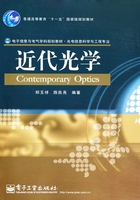
6.4 平面屏幕衍射的基尔霍夫理论[1],[4]
如图6.4-1所示,在一个无限大不透明屏上开有孔径A,用一个点光源照明孔径,点光源在P0点,现在希望计算在孔径另一侧P点的场。假设孔径在xy平面内,以P点为中心,R为半径作一个球,该球在屏上截面为圆,截圆由两部分组成,一部分为孔径A,另一部分是在不透明屏上的那部分B。

图6.4-1 平面屏幕衍射的基尔霍夫理论图
下面将利用亥姆霍兹和基尔霍夫积分定理来计算P点的场,而选择的积分曲面S包括:①球面C;②被照明的孔径A;③屏上未被照明部分B。这样,由式(6.3-18)得到

下面证明上式中C项随R→∞而趋于零。在曲面C上,n=-r0,r=R,因此有

式中,ΩC为球面C对P点所张的立体角。如果U满足

则在球面C上的积分为零。式(6.4-3)称为索末菲(A.Sommerfeld)辐射条件。这样只需计算A、B区域的积分值即可,即

为此,假设:
(1)在曲面B上,即刚好位于屏的不透明部分后面的积分区域,场U及其导数为零;
(2)在曲面A上,即屏开孔部分积分区域,场U及其导数与无屏时的值相同。
上面所述的假设称为基尔霍夫边界条件。应用这些边界条件,则有

假设从孔径A到P点的距离比波长大得多,则可将上面的积分进一步简化。在这个近似下有

于是得到

其中,α是矢径r与n之间的夹角。假设孔径A用从P0点发出的球面波照明,并假定满足基尔霍夫边界条件,则有

式中,ρ表示从P0点到孔径A上任一点的距离,于是有

其中,假设kρ≫1,即光源到孔径的距离比波长大得多;式(6.4-9)中,ρ0是矢径ρ的单位矢量,β是ρ与n之间的夹角。将式(6.4-9)代入式(6.4-7)得到

上式称为菲涅耳-基尔霍夫衍射公式。式中,因子cosβ-cosα称为倾斜因子,因为孔径的线度通常很小,故α、β分别近似为π、0,于是有

在很多情况下,孔径的线度很小,r与ρ在整个孔径A上无显著变化,因此被积函数的分母中r、ρ可用r'、ρ'来代替。r'、ρ'不妨分别选择为从孔径内的原点到P和P0点的距离。于是,式(6.4-11)可写为

菲涅耳-基尔霍夫衍射公式(6.4-10)中关于r与ρ是对称的,所以P0处点光源在P点产生的场与P处的点光源在P0点产生的场相同。这个结论称为亥姆霍兹互易(或可逆)定理。